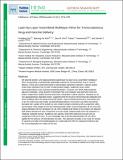Layer-by-Layer-Assembled Multilayer Films for Transcutaneous Drug and Vaccine Delivery
Author(s)
Su, Xingfang; Kim, Byeong-Su; Kim, Sara R.; Hammond, Paula T; Irvine, Darrell J
DownloadIrvine_Layer-by-layer-assembled.pdf (6.499Mb)
OPEN_ACCESS_POLICY
Open Access Policy
Creative Commons Attribution-Noncommercial-Share Alike
Terms of use
Metadata
Show full item recordAbstract
We describe protein- and oligonucleotide-loaded layer-by-layer (LbL)-assembled multilayer films incorporating a hydrolytically degradable polymer for transcutaneous drug or vaccine delivery. Films were constructed based on electrostatic interactions between a cationic poly(β-amino ester) (denoted Poly-1) with a model protein antigen, ovalbumin (ova), and/or immunostimulatory CpG (cytosine−phosphate diester−guanine-rich) DNA oligonucleotide adjuvant molecules. Linear growth of nanoscale Poly-1/ova bilayers was observed. Dried ova protein-loaded films rapidly deconstructed when rehydrated in saline solutions, releasing ova as nonaggregated/nondegraded protein, suggesting that the structure of biomolecules integrated into these multilayer films is preserved during release. Using confocal fluorescence microscopy and an in vivo murine ear skin model, we demonstrated delivery of ova from LbL films into barrier-disrupted skin, uptake of the protein by skin-resident antigen-presenting cells (Langerhans cells), and transport of the antigen to the skin-draining lymph nodes. Dual incorporation of ova and CpG oligonucleotides into the nanolayers of LbL films enabled dual release of the antigen and adjuvant with distinct kinetics for each component; ova was rapidly released, while CpG was released in a relatively sustained manner. Applied as skin patches, these films delivered ova and CpG to Langerhans cells in the skin. To our knowledge, this is the first demonstration of LbL films applied for the delivery of biomolecules into skin. This approach provides a new route for storage of vaccines and other immunotherapeutics in a solid-state thin film for subsequent delivery into the immunologically rich milieu of the skin.
Date issued
2009-11Department
Massachusetts Institute of Technology. Department of Biological Engineering; Massachusetts Institute of Technology. Department of Chemical Engineering; Massachusetts Institute of Technology. Department of Materials Science and Engineering; Ragon Institute of MGH, MIT and Harvard; Koch Institute for Integrative Cancer Research at MITJournal
ACS Nano
Publisher
American Chemical Society
Citation
Su, Xingfang, Byeong-Su Kim, Sara R. Kim, Paula T. Hammond, and Darrell J. Irvine. “Layer-by-Layer-Assembled Multilayer Films for Transcutaneous Drug and Vaccine Delivery.” ACS Nano 3, no. 11 (November 24, 2009): 3719-3729.
Version: Author's final manuscript
ISSN
1936-0851
1936-086X